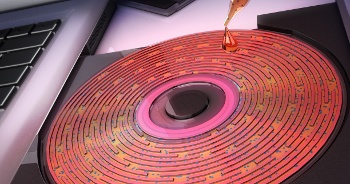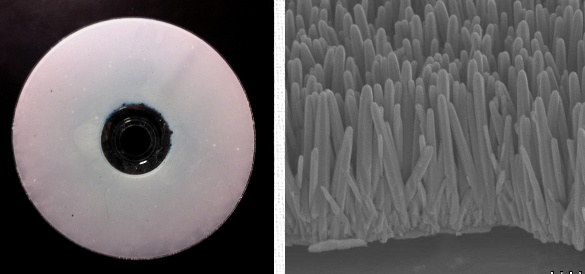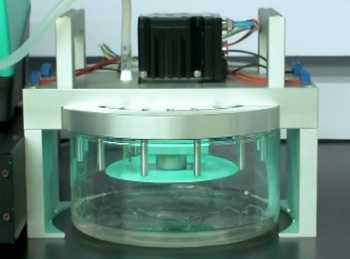Water Purification 'CD'
October 14, 2013
As other
scientists with an interest in
computing, I was an early user of the
Internet, both at work, and at home. This was at the time when access to the
World Wide Web was through the
Mosaic Web Browser, and there was no
Google Search. I used
AltaVista.
I had an
Ethernet connection at work, but only
dial-up at home, initially at 1200
baud, migrating notably to 9,600 baud, then to
V.34, the limit of what the
plain-old-telephone-service (POTS) could provide (about 33,600 baud). I had an additional
telephone line installed at my home exclusively for dial-up Internet, and I used a local
Internet service provider (ISP).
In those dial-up days, non-computer people were led to believe that a company called
AOL was the Internet. AOL blitzed people with copies of their
interface software by
direct mail, first via
floppy disks, then
compact disks (CDs). These offered free connection hours before access rates began. It's been reported that at one time, half of manufactured CDs contained AOL software, and the total cost of AOL CDs was more than $300 million.[1]
Although I didn't keep an accurate count, I personally received more than twenty AOL CDs over the years. Others had this same experience, and you can find web sites that list uses for AOL CDs other than their intended purpose.[2] CDs are made from
polycarbonate, a useful
structural material, so the CDs were used as
beverage coasters,
ice scrapers and
grill scrapers, and
vegetable garden markers. Since CD grooves form an
optical diffraction grating, you can use a CD to make a crude
spectrometer.[3]

Chemical structure of Lexan™ polycarbonate. Lexan is formed in a reaction of bisphenol-A with phosgene. (Image via Wikimedia Commons.)
Using a CD as a drink coaster is fairly obvious, but scientists have found some technically exquisite uses for CDs.
Professor Gang Logan Liu of the
University of Illinois Micro and Nanotechnology Lab and his
research team have developed a "
lab-on-a-chip"
medical diagnostic system using CDs formed as
microfluidic devices which can be read by standard
computer CD drives (see image).[4] Such low cost devices can enable enhanced
health care in remote or
impoverished regions.

Microfluidic CD system for lab-on-chip medical diagnostics.
(Image courtesy of Professor Gang Logan Liu of the University of Illinois Micro and Nanotechnology Lab.)[4)]
Another need in remote or impoverished regions is
clean water, and CDs have again been employed to solve this technical problem.
Din Ping Tsai, a
physicist at
National Taiwan University, and his
colleagues from the National Applied Research Laboratories in
Taiwan, and the Research Center for Applied Sciences in Taiwan, have developed a water treatment
photocatalytic reactor based on a
zinc oxide coated CD.[5-6] Just as in its more typical application, the CD spins.
They prepared a sea of upright zinc oxide
nanorods on the surface of a CD (see photos). Zinc oxide is a well-known
photocatalyst for the
decomposition of
organic pollutants, and it will break apart organic molecules in sewage under
ultraviolet illumination.[5] The essential trick is that the rapidly-spinning CD will spread
droplets of
fluid dripped onto it into a thin sheet of
liquid which allows more efficient photocatalysis.[5]

A CD coated with a zinc oxide nanorod photocatalyst (left), and a scanning electron micrograph of the zinc nanorods(right). The scale of the micrograph is about ten micrometers across the width of the image. (OSA/Din Ping Tsai/National Taiwan University images.)[5)]
The treatment reactor, as shown in the photograph, is about a
cubic foot in
volume. The reactor includes the
UV light sources and a
water recirculating system. As a test, the Taiwanese research team used a
solution of
methyl orange dye, an organic compound often used to test the
efficiency of photocatalytic reactions. It was found that 95% of the methyl orange dye had been broken down after treatment of a
half-liter solution for 60 minutes. Based on this observation, it appears that the reactor could treat 150
mL of
waste water per minute.[5]

Photocatalytic reactor using a ZnO nanorod catalyst on a spinning compact disk.
(Din Ping Tsai/National Taiwan University, a still image from a video supplied by The Optical Society)
Of course, one possible improvement of the system is to have a stack of spinning disks spun by a single
motor. The system could find utility in the treatment of not only
domestic sewage, but also
farm waste,
urban run-off, and
industrial effluents.[5] I can see how this type of system can be used, also, for
air purification when shaped
impellers are used. Considering the current
environmental problems of
mainland China, this might be a useful
export across the
Taiwan Strait.
References:
- MG Siegler, "How Much Did It Cost AOL To Send Us Those CDs In The 90s? 'A Lot!,' Says Steve Case," Tech Crunch, December 27, 2010.
- 101 uses for AOL disks, EarthPlaza.com
- Andrew Steele, "Make your own CD spectrometer," YouTube Video.
- Syed M. Imaad, Nathan Lord, Gulsim Kulsharovaa and Gang Logan Liu, "Microparticle and cell counting with digital microfluidic compact disc using standard CD drive," Lab on a Chip, vol. 11, no. 8 (April 21, 2011), pp. 1448-1456.
- Spinning CDs to Clean Sewage Water, Press Release of the Optical Society, September 23, 2013.
- Web Site of The 97th OSA Annual Meeting and Exhibit/Laser Science XXIX: Frontiers in Optics, October 6-10, 2013, Orlando, Florida. Presentation FW1A, "Zinc Oxide Nanorod Optical Disk Photocatalytic Reactor for Photodegradation," was scheduled for Wednesday, October 9, 2013, at 8:15 AM.
Permanent Link to this article
Linked Keywords: Scientist; computing; Internet; World Wide Web; Mosaic Web Browser; Google Search; AltaVista; Ethernet; dial-up Internet access; baud; ITU-T V.34; plain-old-telephone-service; telephone line; Internet service provider; AOL; interface software; direct mail; floppy disk; compact disk; polycarbonate; structural material; beverage coaster; ice scrapers; barbecue grill; vegetable garden; optical diffraction grating; spectrometer; Lexan™; bisphenol-A; phosgene; Wikimedia Commons; Professor; Gang Logan Liu; University of Illinois Micro and Nanotechnology Lab; research; lab-on-a-chip; medical diagnosis; medical diagnostic; microfluidics; microfluidic device; optical disc drive; computer CD drive; health care; Third World; impoverished region; drinking water; clean water; Din Ping Tsai; physicist; National Taiwan University; colleague; Taiwan; photocatalytic; chemical reactor; zinc oxide; nanorod; photocatalyst; chemical decomposition; organic compound; organic chemical; pollutant; ultraviolet; drop; droplet; fluid; liquid; scanning electron microscope; micrograph; micrometer; cubic foot; volume; ultraviolet LED; UV light source; water; solution; methyl orange dye; yield; efficiency; liter; mL; waste water; The Optical Society; electric motor; domestic sewage; farm waste; urban run-off; industrial effluent; air purifier; air purification; impeller; environmentalism; environmental problems; mainland China; export; Taiwan Strait.